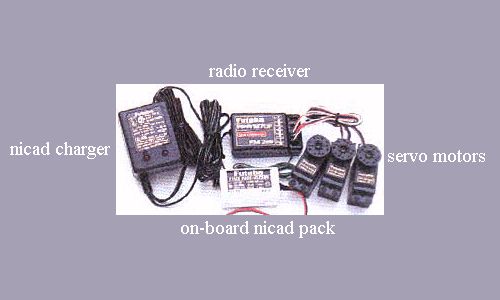
The onboard flight system is no different from a gas-powered plane's; a receiver in the amateur radio 50 MHz band or the R/C 72 MHz band extracts the signal from the transmitter and decodes it using AM, FM or PCM modulations. The signal is then transferred to several servo motors, each of which is responsible for a particular control surface. The receiver and servos are powered by a small nicad battery pack.
When constructing an electric, use the smallest practical receiver nicads and servos for your situation. Weight conservation here will make a better flying plane in the end.

The transmitter of course is no different for electrics -- rudder and throttle on the left stick, aileron and elevator on the right stick. Flaps and retractable landing gear, if applicable, may be controlled by knobs and switches on the top. This particular transmitter can control 6 functions, or 'channels'. A 4-channel radio is usually sufficient for flying -- many planes, such as unpowered gliders, need only 2 channels (elevator and rudder).
There are several dozen allocated frequencies for R/C flying, each one is designated by a 'frequency number' which appears as a flag attached to the outstretched transmitter antenna (not shown here). At flying fields it is very important that no two flier be using the same frequency at any one time. Bad things happen otherwise.
A common question is 'how far away can you control the plane'? For all but the largest planes, you can control the plane as long as you can see the airplane. Generally, this corresponds to a range (in the air) of 1/2 mile or so.